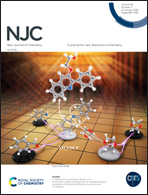Highly dispersed rhodium atoms supported on defect-rich Co(OH)2 for the chemoselective hydrogenation of nitroarenes
Abstract
Catalysts of 0.54% (Pt, Rh, Pd or Ru)/Co(OH)2 and 1.23% Rh/Co(OH)2 were successfully synthesized via simple hydrothermal and precipitation methods for the selective hydrogenation of nitroarenes. It was found that 0.54% Rh/Co(OH)2 outperformed other catalysts, for example, 2-chloronitrobenzene hydrogenation (with a turnover frequency (TOF) of 575 h−1) under 3.0 MPa H2 at 100 °C for 1 h (much higher than that of 1.23% Rh/Co(OH)2; TOF, 398 h−1). Through characterization of the nanostructure (XRD, TEM, HRTEM, AC-STEM (spherical aberration-corrected scanning transmission electron microscopy), AC-STEM-EDX elemental mapping and line-scanning, H2-TPD, etc.), it was confirmed that Rh was dispersed in the form of single atoms and ultrasmall nanoclusters on Co(OH)2 for 0.54% Rh/Co(OH)2. Moreover, 0.54% Rh/Co(OH)2 also exhibited high selectivity for –NO2 hydrogenation for other selected nitroarene substrates hydrogenation reactions. This was mainly attributed to the presence of Rh as single atoms or super tiny nanoclusters in 0.54% Rh/Co(OH)2, leading to a significant increase in the number of active sites, beneficial adsorption of the –NO2-group at defect-rich Co(OH)2, and an interfacial synergy effect of Rh–Co(OH)2, thus improving the catalytic performance.



 Please wait while we load your content...
Please wait while we load your content...